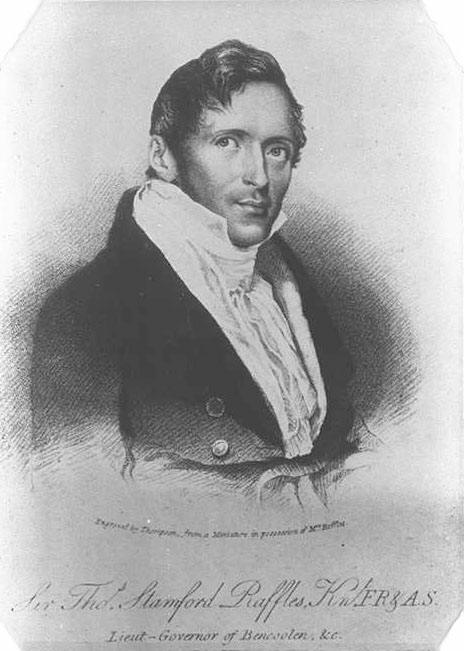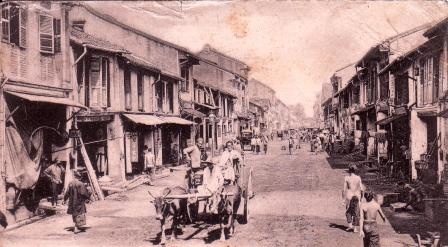The different shops in China Town
3. Research & Fieldwork
Research Findings
We based most of our research on Internet websites (sources at the bottom of the blog) but we have also refered to relevant parts of our History books as Chinatown is a historical landmark in Singapore. Some of our knowledge of Chinatown also come from our own personal experience in Chinatown.
Through our fieldwork, we have found out many more things about Chinatown past, culture and tradition. We worked together and collected information about the heritage of chinatown. We also went to Chinatown Heritage Centre to view the exhibits there which displays the history of Chinatown.
We learned:
In 1819, Stamford Raffles (later Sir Stamford) of the British East India Company established a trading settlement in Singapore. Before leaving for Java, he appointed William Farquhar to be the first British Resident and Commandant of Singapore from 1819 to 1823.

Within Chinatown, each dialect group occupied distinct areas and built social institutions such as clan associations to serve the collective needs of each dialect group.
Hokkien Street

We based most of our research on Internet websites (sources at the bottom of the blog) but we have also refered to relevant parts of our History books as Chinatown is a historical landmark in Singapore. Some of our knowledge of Chinatown also come from our own personal experience in Chinatown.
- We found out that Chinatown is organised and categorised into many precints, like Kreta Ayer and Telok Ayer.
- The Chinese name for Chinatown (牛车水) means 'bull-cart water' because in the early years of Singapore, fresh water was transported from place to place by carts pulled by bulls and buffalos.
- Unlike the rest of Singapore, Chinatown preseves most of it's traditional culture in the forms of the original buildings and places of worship, like the Jamae Mosque and the Sri Mariamman Temple.
Through our fieldwork, we have found out many more things about Chinatown past, culture and tradition. We worked together and collected information about the heritage of chinatown. We also went to Chinatown Heritage Centre to view the exhibits there which displays the history of Chinatown.
We learned:
In 1819, Stamford Raffles (later Sir Stamford) of the British East India Company established a trading settlement in Singapore. Before leaving for Java, he appointed William Farquhar to be the first British Resident and Commandant of Singapore from 1819 to 1823.

Within Chinatown, each dialect group occupied distinct areas and built social institutions such as clan associations to serve the collective needs of each dialect group.
The Hokkien population grew and the Hokkien clan association known as the Hokkien Huay Kuan was formed to address the needs of the migrant population.
The Hakkas built their Ying Fo Fui Kui Clan Association further down the road while the Teochews built the Wak Hai Cheng Bio at the Philip Street. The Cantonese congregate around Smith Street, Temple street and Mosque street area. Chinese communities also developed outside of this official Chinatown. Hakkas lived around Bugis area.
Hokkien Street

4. Effects of Globalisation
It is evident that Chinatown has overgone a drastic change over the years. Chinatown, is being marketed as a tourism attraction in Singapore. Tourism manifests globalization prominently due to its global movement and scale. Many tourists visit Chinatown as it is now a tourist attraction.
In the past, Chinatown was just a poor and small settlement. The shophouses and houses were built in brick and tiled, each house should have a veranda or covered passage five feet wide to provide an open space where the dwellers in the crowded houses could have fresh air and also where food hawkers could operate. The houses and shophouses were built in neat rows and in the centre was an air-well open to the sky. This served for the collection and storage of water for ventilation and light.
As years go by, more and more tourists come to Chinatown as it is a tourist attraction which sells good food, clothes and many other souvenirs. Chinatown also has a Heritage Centre which displays exhibits of Chinatown in the past. This evidence shows that Chinatown has changed due to globalization. Globalization has also resulted in Chinatown having a bigger range of products sold. Nowadays, the products mostly come from China and Malaysia, but some also come from other countries as well.
This is one of the results of globalisation. As Singapore has developed relationships with other countries around the world, more trade opportunities appear. And with the advancements in technology, transporting goods from one part of the world to the other has become so much more convinient and quicker. In the past, goods had to be transported by ships. Now, there are jet carriers that can cover a longer distance faster than the ships in the early days. With the shorter time span, the food would take a longer time to go bad after reaching the country. This improves international trade.
Globalisation has also invited more foreign workers to Chinatown. As more shops and restaurants open, jobs like shop assistants and waiters will become available. Though most of them are locals, we have spotted some foreigners working in Chinatown during our fieldtrip. Another example is a Belgium shop that opened up in one of the shops in Chinatown. Though it seemed out of place in a lane selling Chinese goods and tourist soveniors, this only proves that shops are expanding across countries and that globalisation is occuring.
In the past, Chinatown was just a poor and small settlement. The shophouses and houses were built in brick and tiled, each house should have a veranda or covered passage five feet wide to provide an open space where the dwellers in the crowded houses could have fresh air and also where food hawkers could operate. The houses and shophouses were built in neat rows and in the centre was an air-well open to the sky. This served for the collection and storage of water for ventilation and light.
As years go by, more and more tourists come to Chinatown as it is a tourist attraction which sells good food, clothes and many other souvenirs. Chinatown also has a Heritage Centre which displays exhibits of Chinatown in the past. This evidence shows that Chinatown has changed due to globalization. Globalization has also resulted in Chinatown having a bigger range of products sold. Nowadays, the products mostly come from China and Malaysia, but some also come from other countries as well.
This is one of the results of globalisation. As Singapore has developed relationships with other countries around the world, more trade opportunities appear. And with the advancements in technology, transporting goods from one part of the world to the other has become so much more convinient and quicker. In the past, goods had to be transported by ships. Now, there are jet carriers that can cover a longer distance faster than the ships in the early days. With the shorter time span, the food would take a longer time to go bad after reaching the country. This improves international trade.
Globalisation has also invited more foreign workers to Chinatown. As more shops and restaurants open, jobs like shop assistants and waiters will become available. Though most of them are locals, we have spotted some foreigners working in Chinatown during our fieldtrip. Another example is a Belgium shop that opened up in one of the shops in Chinatown. Though it seemed out of place in a lane selling Chinese goods and tourist soveniors, this only proves that shops are expanding across countries and that globalisation is occuring.
 |
| The TinTin shop is a Belgium shop in Chinatown. |
2. Chinatown in the Past
Chinatown- Past

Chinatown- Present

Jobs in Chinatown in the past:
1. Rickshaw pullers
2. Hawkers
3. Blacksmiths
4. Carpenters
5. Shop vendors
6. Tailors
7. Physician
Life in Chinatown in the past:
-Highly overcrowded
-Limited facilities (the residents of a block had to share one toilet)
-High poverty rate
-Chinese separated by clan group/dialect
-Hokkiens: Settled around Telok Ayer. Took on trade and commerce.
-Teochew: Settled along Singapore River (Clarke Quay) and around Fort Canning. Specialized in agriculture, such as gambier and pepper.
-Cantonese and Hakka: Settled around Kreta Ayer. Became miners and artistians, such as carpenters and goldsmith (Cantonese) and niche trade and pawn booking (Hakka).
-Hainanese: Service industries, such as assistants and waiters.
Products/Services of Chinatown in the past:
-Herbs and spieces: Nutmeg, Clove and Coriander
-Wanton Noodles
-Silk
-Calligraphy
-Shoe Polishing

Chinatown- Present

Jobs in Chinatown in the past:
1. Rickshaw pullers
2. Hawkers
3. Blacksmiths
4. Carpenters
5. Shop vendors
6. Tailors
7. Physician
Life in Chinatown in the past:
-Highly overcrowded
-Limited facilities (the residents of a block had to share one toilet)
-High poverty rate
-Chinese separated by clan group/dialect
-Hokkiens: Settled around Telok Ayer. Took on trade and commerce.
-Teochew: Settled along Singapore River (Clarke Quay) and around Fort Canning. Specialized in agriculture, such as gambier and pepper.
-Cantonese and Hakka: Settled around Kreta Ayer. Became miners and artistians, such as carpenters and goldsmith (Cantonese) and niche trade and pawn booking (Hakka).
-Hainanese: Service industries, such as assistants and waiters.
Products/Services of Chinatown in the past:
-Herbs and spieces: Nutmeg, Clove and Coriander
-Wanton Noodles
-Silk
-Calligraphy
-Shoe Polishing
1. Problems Faced During Fieldwork Activity (Group Reflection)
We had problems finding out the origin for the products that are sold in the shops. We approached the shop assistant for help and we, as a group, searched different products for the origin so that we will be able to finish faster. However, most of the shops were closed and we had problems marking out the map with consecutive shops as we did not even know what was sold. For example, we had to guess what the products were sold at a certain shop based on it's name if it was closed. It was difficult as there were even some shops with absolutely no name or had the same name as another.
We also had problems piecing our findings together. As we were split into separate groups, not all of our findings were consistent and there were parts that we had left out in our recordings in the haste to finish the station. However, we already had information of Chinatown beforehand and filling in the blanks was not much of a problem. For example, we had problems doing the station based on the temples and religion as not much was explained to us during the trip. However, we had researched them and related them to whatever we had recorded about the station.
 |
| We had problems mapping out consecutive shops as some were closed. (But we took pictures of them anyway!) |
Subscribe to:
Posts (Atom)
